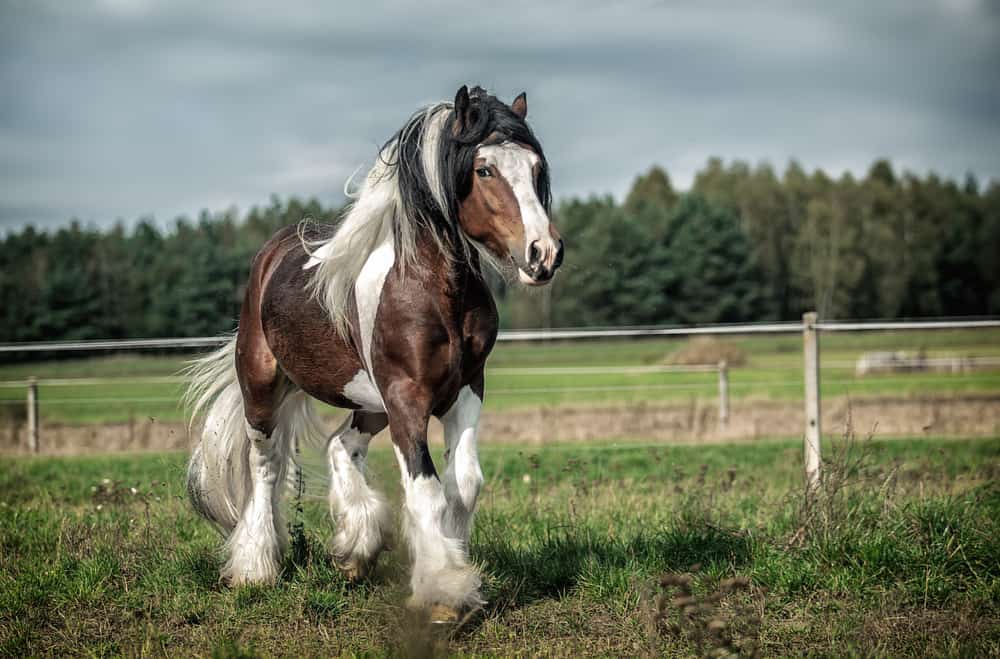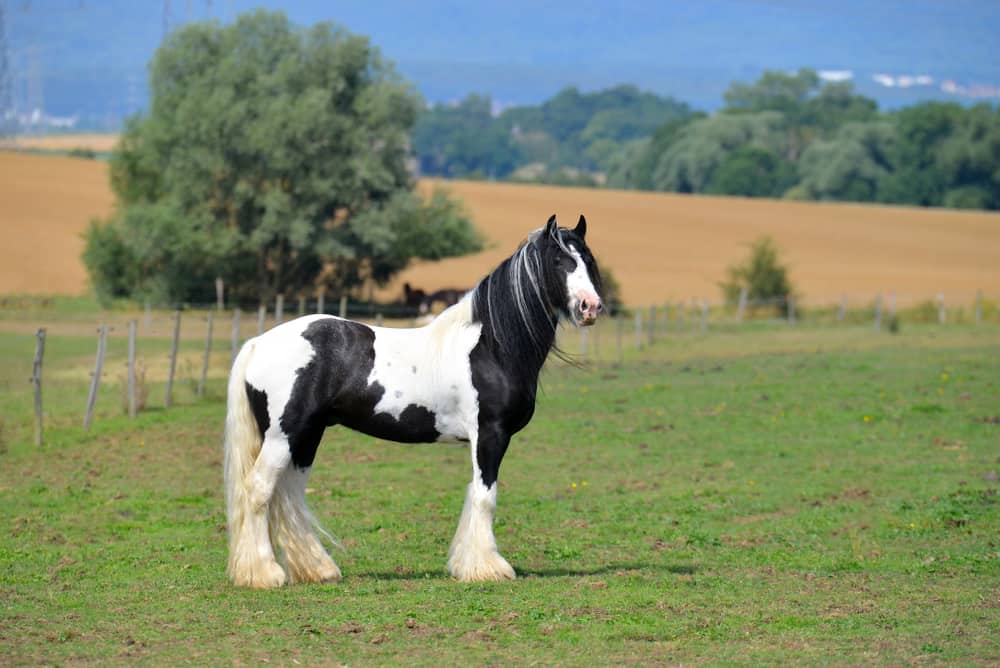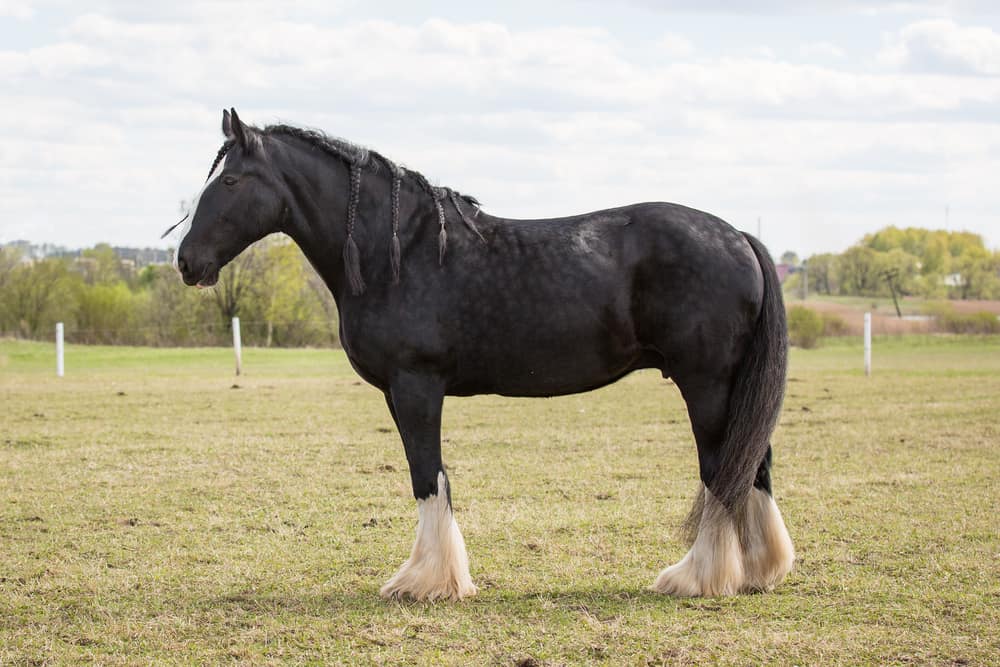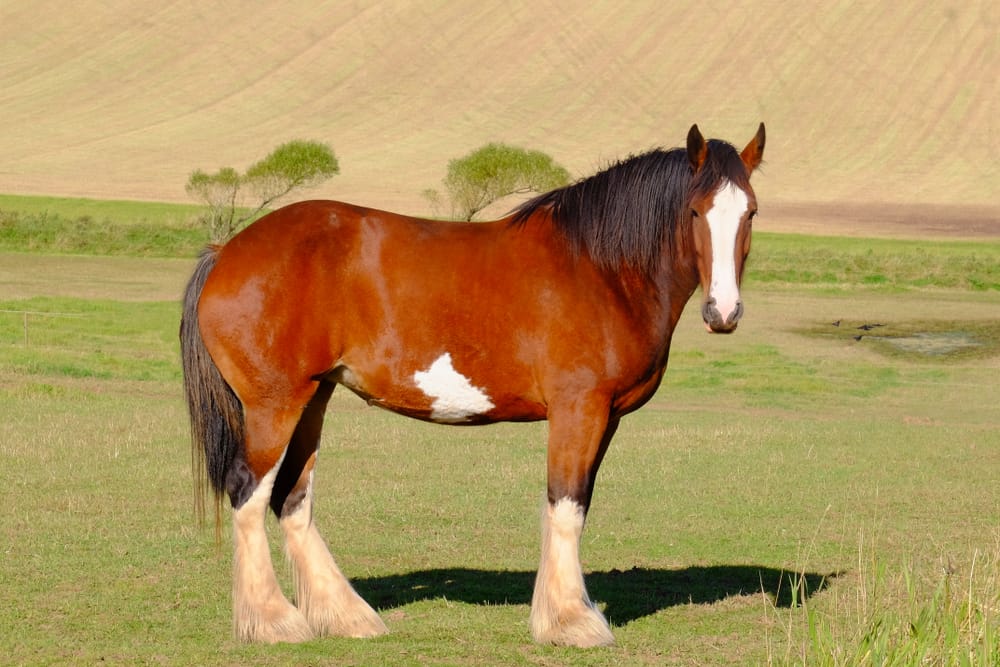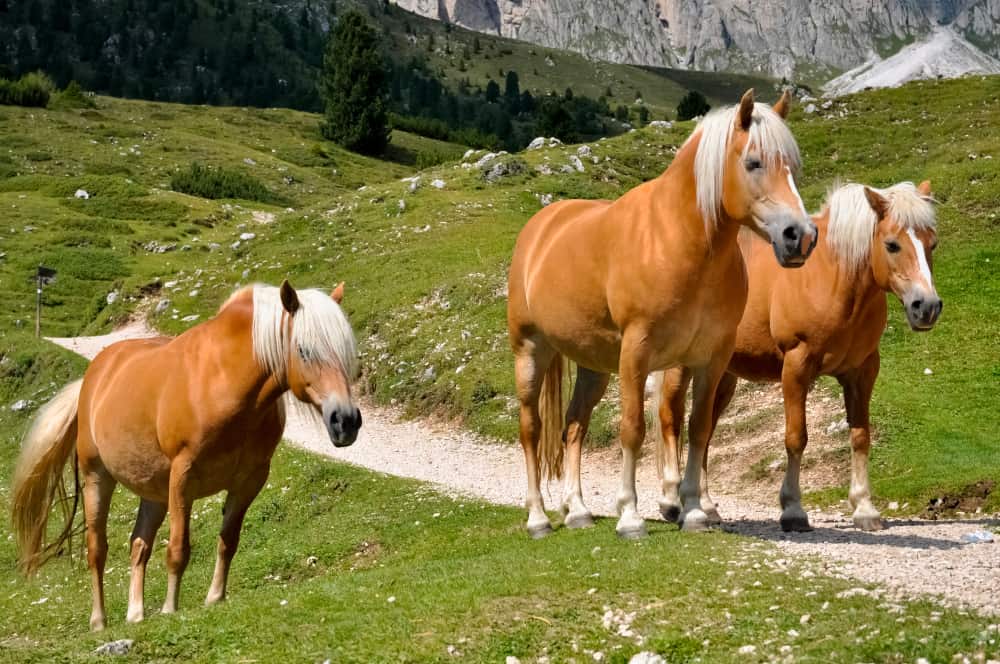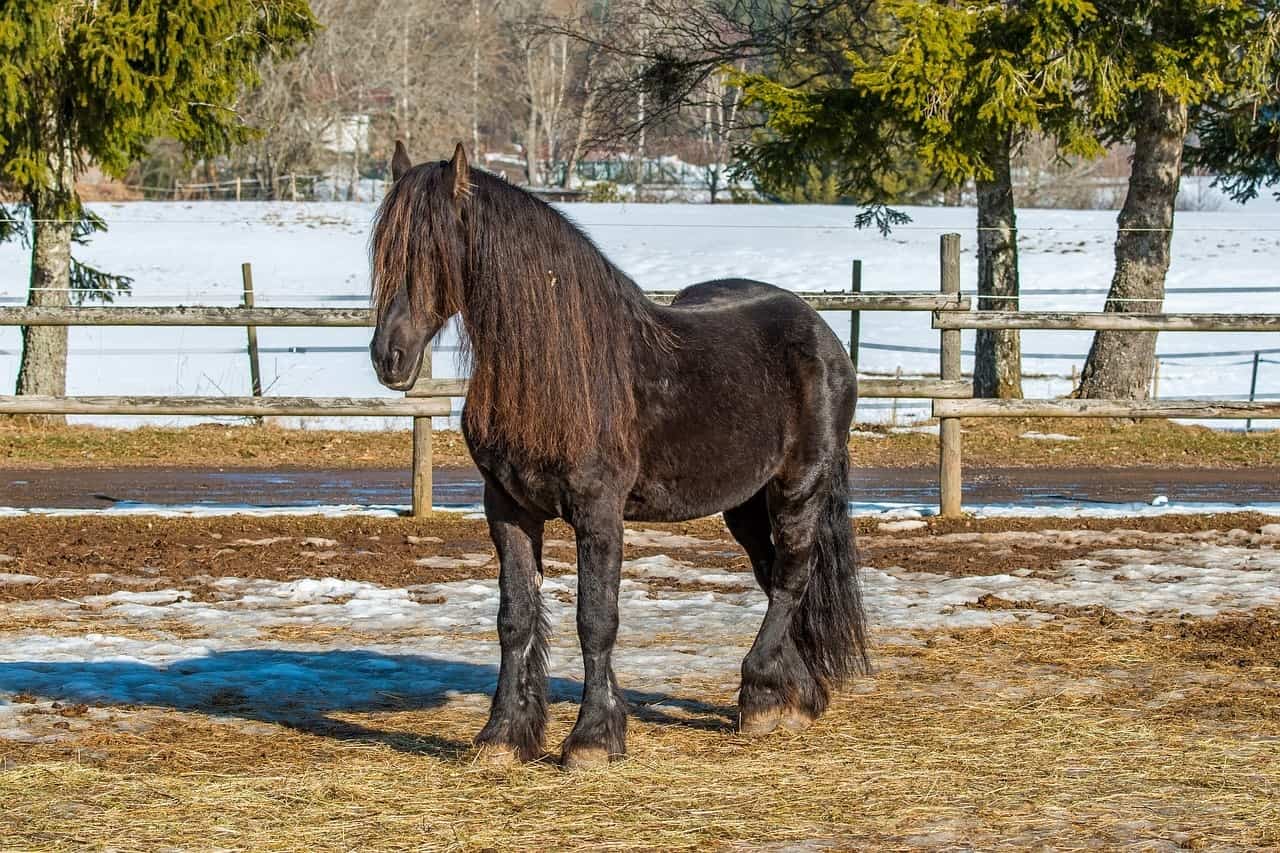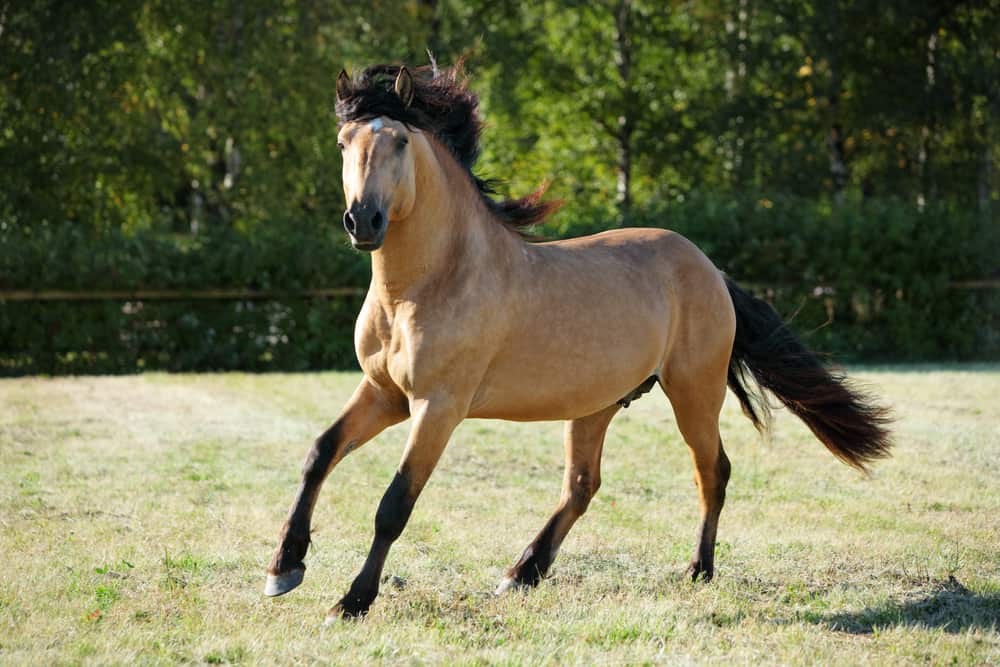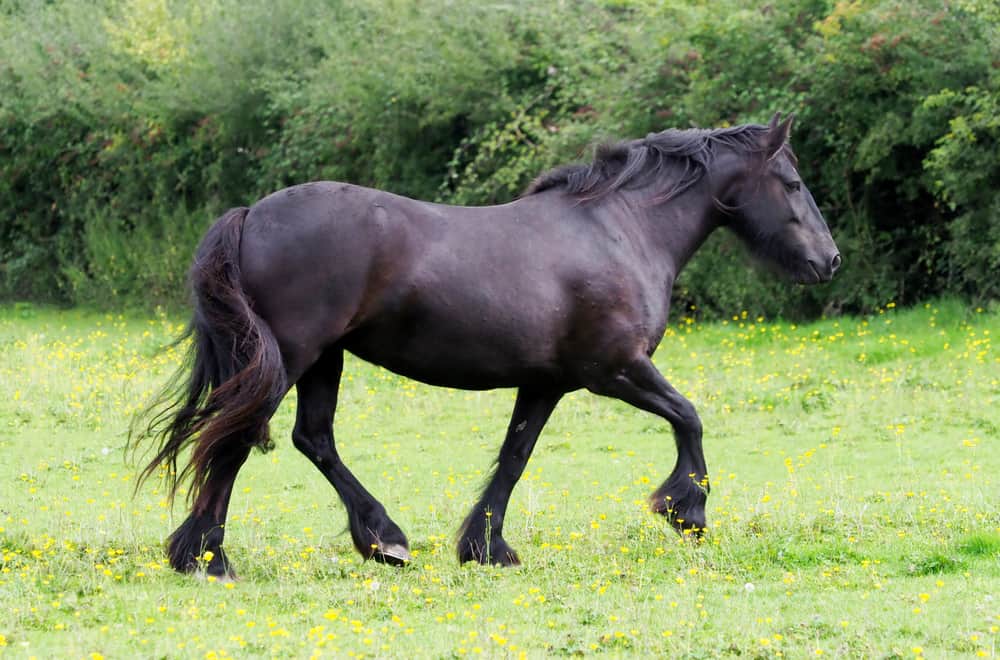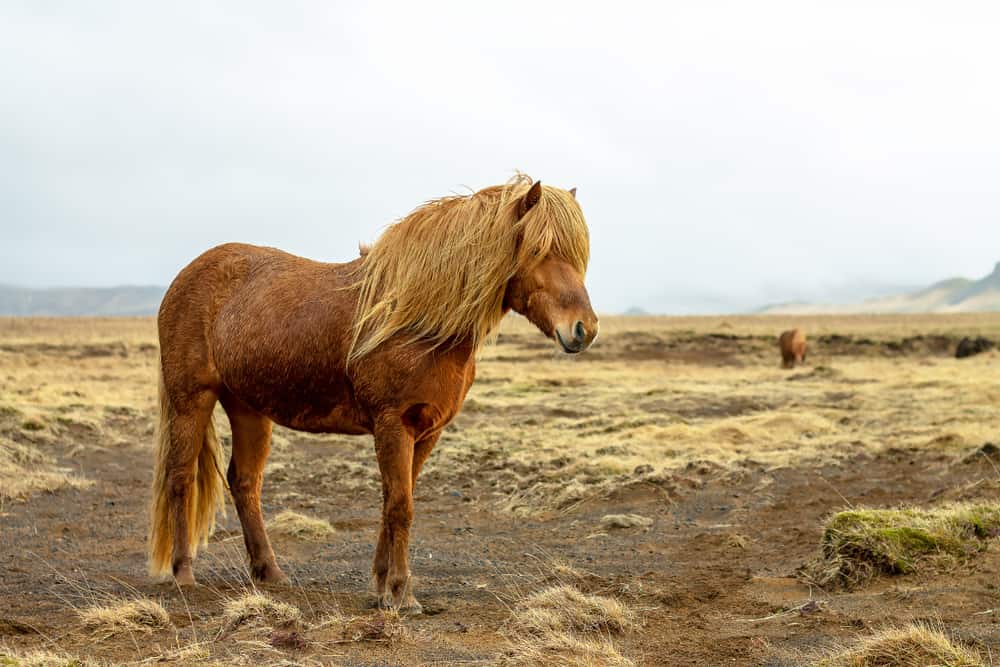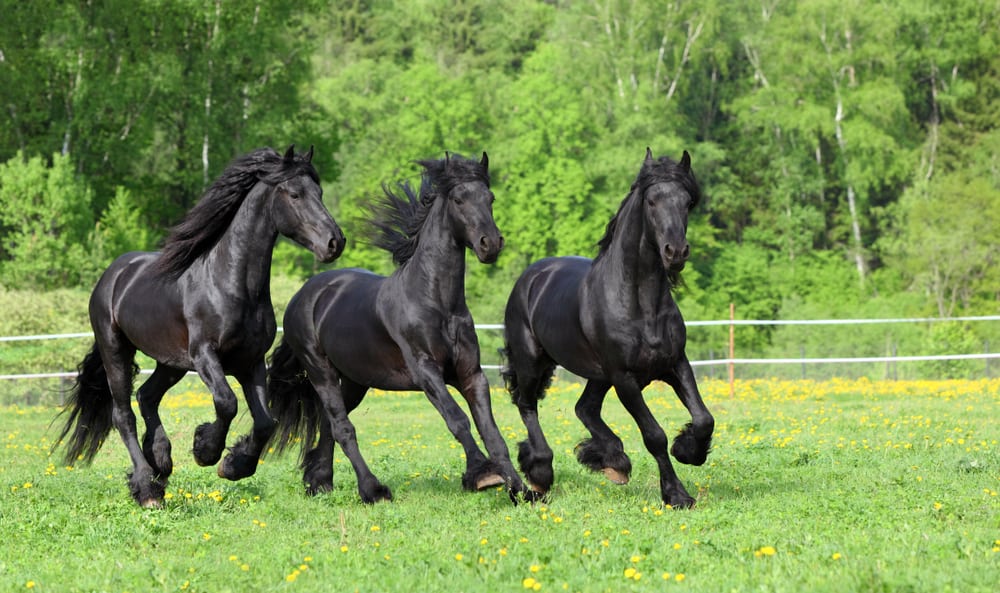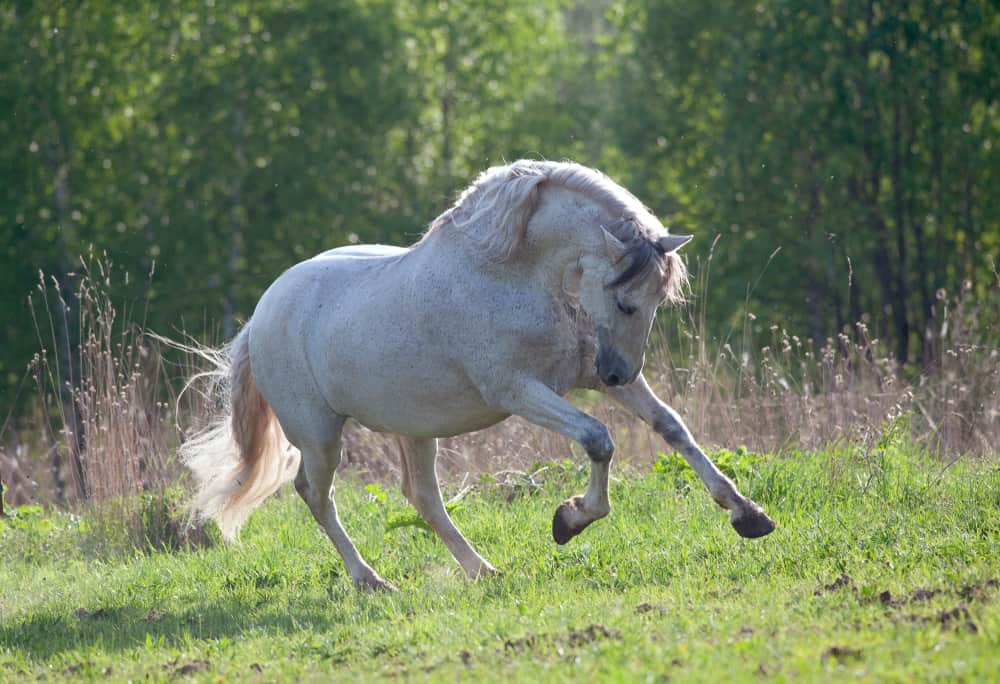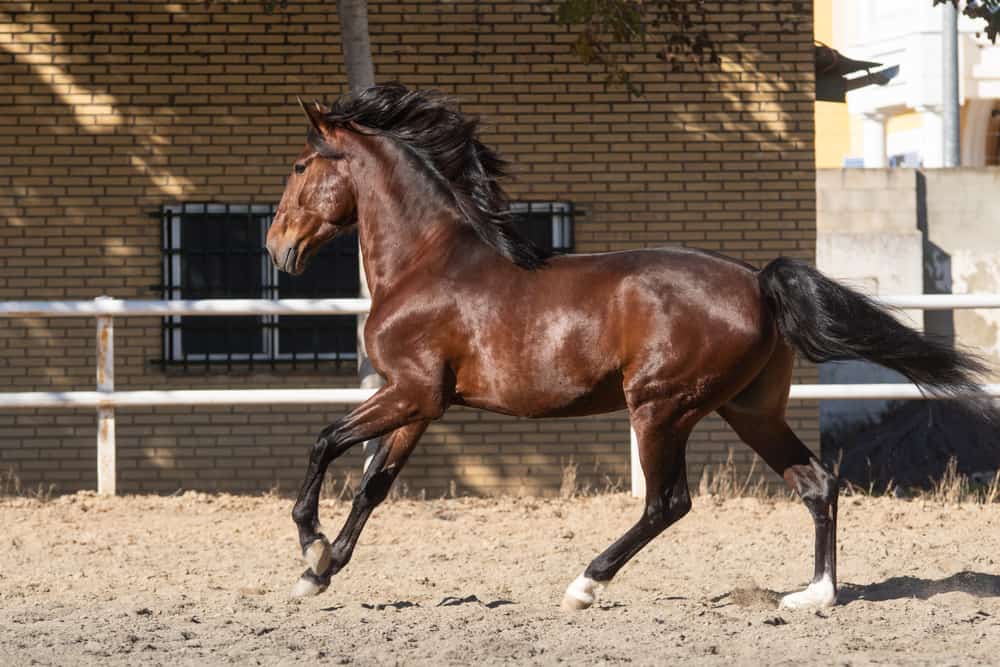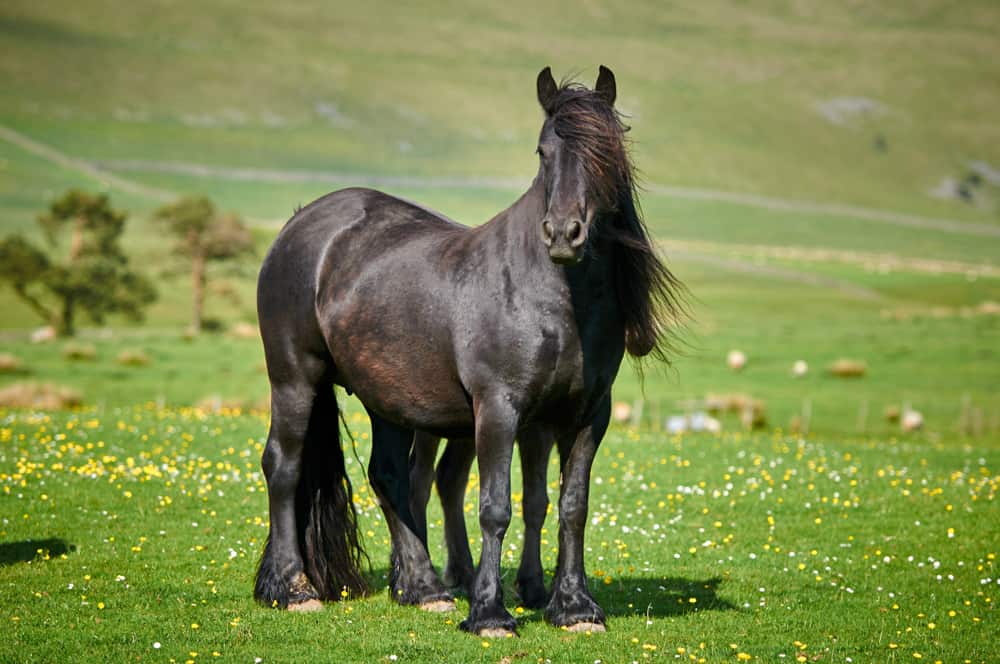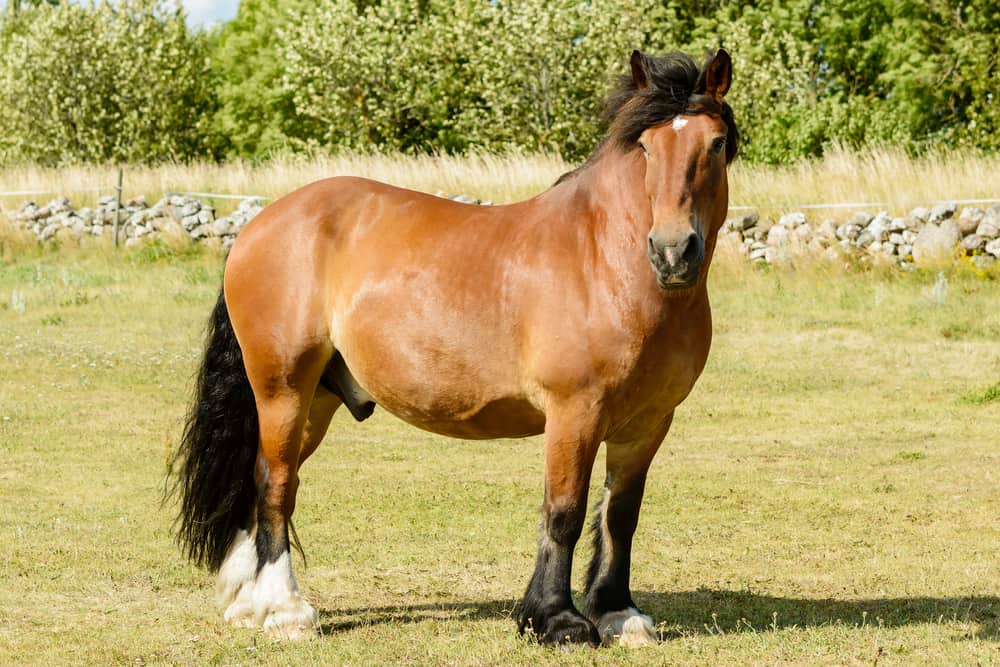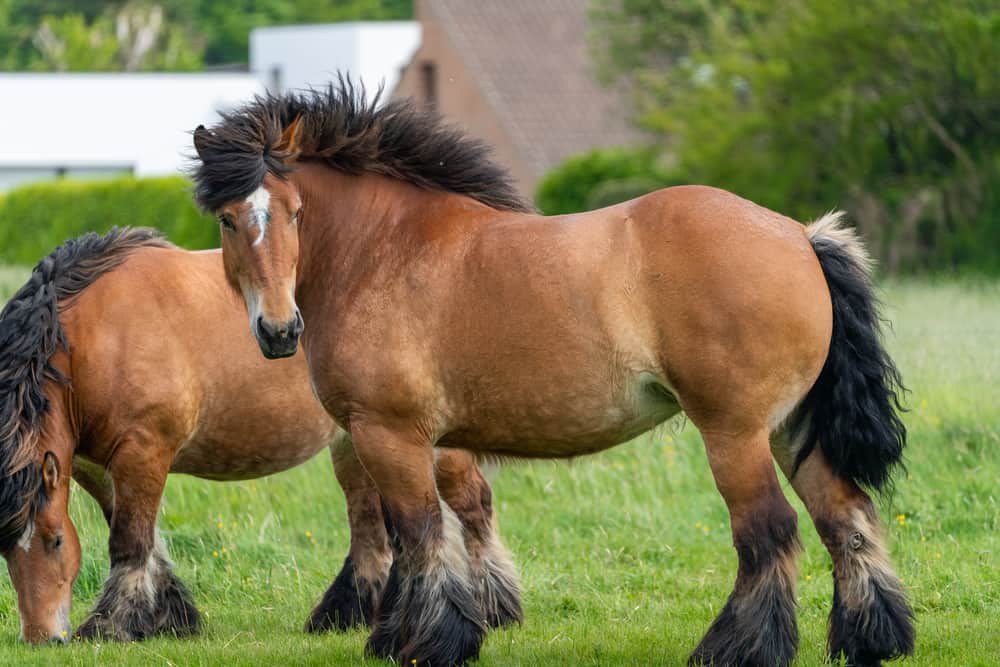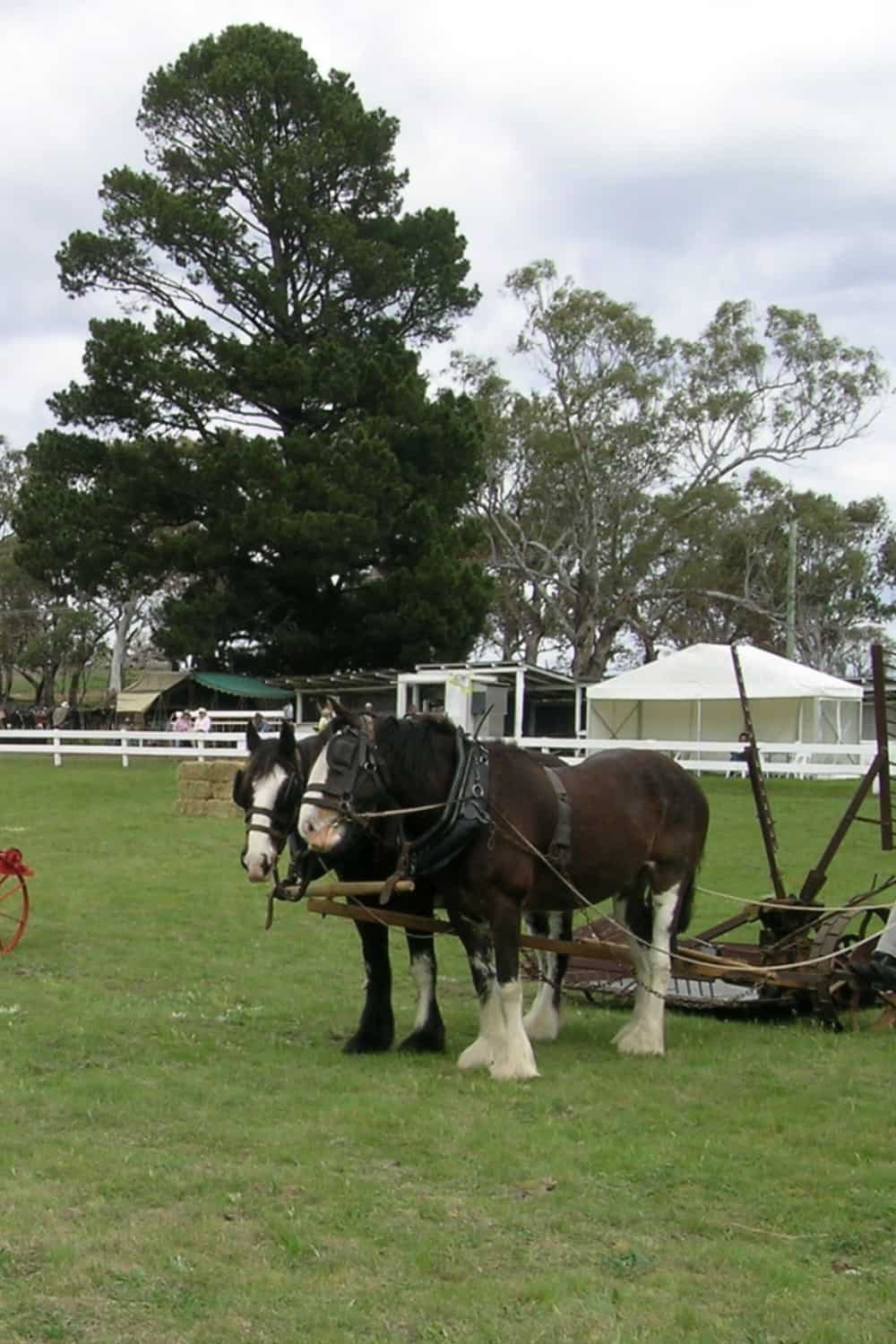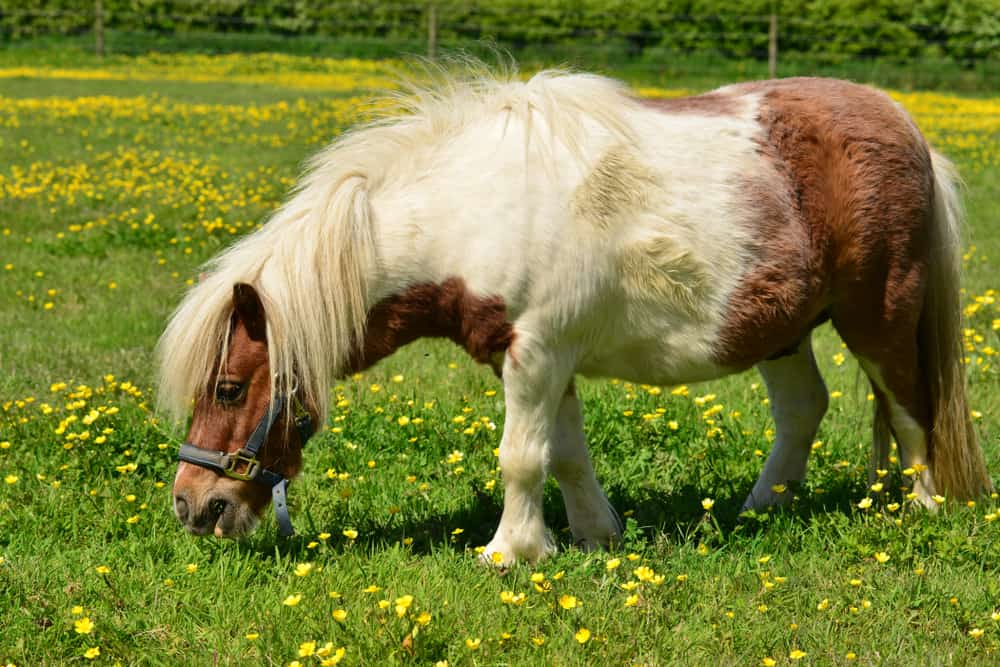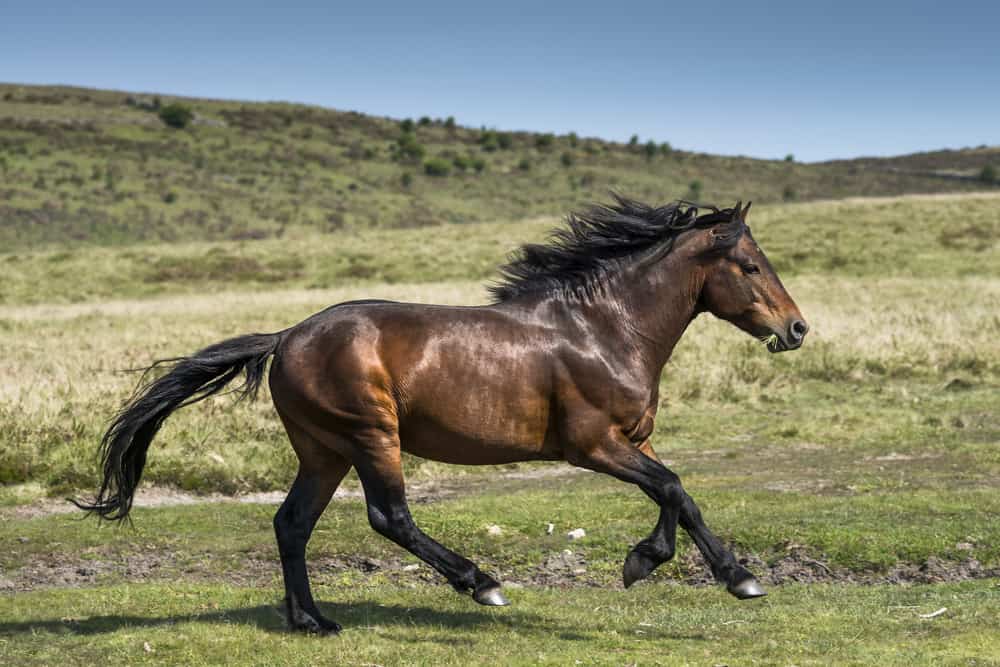We love horses! All colors, all breeds and all sizes. But horses with long hair have a charm all of their own.
We’re going to take a look at 17 of the most distinctive and beautiful long haired horse breeds around the world. So settle back and enjoy learning more about these incredible animals!
1. Gypsy Vanner
The gorgeous Gypsy Vanner is known for its long, flowing mane and tail, and its feathered heels. Its coat is most commonly piebald, but you’ll also find skewbald and solid color horses.
There are different standards for the breed in different parts of the world. The American breed registries are most restrictive, with both larger and lighter horses permitted in Europe.
The horses were traditionally used to pull vardos, the caravans of Gypsies and Irish Travellers. Today, you’ll find them being traded at horse fairs and appearing in parades. In the USA, Gypsy Vanners also compete in dressage events.
2. Shire Horse
The Shire horse is one of the largest and most majestic of breeds. They have fine, long, silky hair with distinctive feathering on the legs. Most Shires are black, bay, roan or gray.
They’re very strong animals, and were traditionally used in agriculture, pulling machinery like ploughs.
Shires have held the world records for both the heaviest and the tallest horses. Their average height is around 17.2 hands, but they can be much taller. Probably the largest horse in history was a Shire aptly named Mammoth. He stood 21.2 hands high, and weighed 3,360 pounds.
Shire horses are gentle giants, though, known for their calm and easy-going disposition. Today, you’ll find the breed used in forestry and for leisure riding.
3. Clydesdale
Like the Shire horse, the Clydesdale is a draft breed. It takes its name from the area where it originated, Clydesdale in the county of Lanarkshire, Scotland. The breed first appears in written records early in the 19th century.
Today’s Clydesdales are taller than their ancestors, and stand between 16 and 18 hands. Most have bay colored coats, but you can also find the Sabino pattern as well as chestnut, gray and black horses. Their long hair is seen primarily in the luxurious feathering on their lower legs.
They’re strong animals, and can still be found at work today in forestry and farming. And those beautiful feathered feet mean they’re often seen cutting a dash in parades and pulling carriages.
4. Haflinger
The striking Haflinger is known for its flowing, white or flaxen mane and tail. Their coats are always chestnut, but the shade can vary from light gold all the way through to liver.
The breed originated in the 19th century in the Hafling region of the South Tyrol, which straddles Italy and Austria. They’re suited to that area’s mountainous terrain, being renowned as hardy animals. Even today, you’ll find them in the Austrian army, where they’re used as packhorses.
They’re kind and quiet horses – that’s even checked as part of the process for registering a horse! So perhaps it’s not surprising that they’re used in a range of different ways.
As well as their military duties, you’ll find Haflingers doing light draft work. And they’re also popular for riding, whether as therapeutic horses, for equestrian vaulting or in dressage.
5. Black Forest Horse
The Black Forest horse is another breed with a dramatic color combination. These horses are always chestnut. Coats can be anywhere between pale gold and so dark they’re almost black. And their flowing manes are always flaxen.
Unlike some other draft breeds, these horses don’t have feathering. They’re well-muscled animals with a lighter build and broad, strong hooves.
Their strength reflects the purpose for which they were originally bred, as working animals used in forestry and agriculture. Today, though, you’re more likely to find Black Forest horses being ridden or pulling carriages.
6. Paso Fino
You can find the beautiful Paso Fino in lots of different colors and sizes. But what all these horses have in common are long, abundant manes and tails. And they have bright, lively temperaments.
The breed has two strains, the Colombian and the Puerto Rican. The Puerto Rican Paso has another unusual feature – what’s known as the “tiger’s eye”. This is a genetic variant that lightens the horse’s eye color. The result can be anything from amber through to bright orange.
Both strains walk with a natural ambling gait, which makes them very comfortable rides. There are specialist Paso Fino horse shows. But you can also find Pasos being ridden in gymkhana, on trails and in endurance events.
7. Dales Pony
The Dales pony takes its name from its heartlands, the Yorkshire Dales in England. It’s one of Britain’s native breeds, and it’s adapted to survive the harsh winters on the moors.
It has a long, thick and silky mane and tail, and long feathers on its legs. Most Dale ponies are black, but you can also find examples with gray, brown, roan and bay coats. They’re powerful and energetic animals, known for being alert, brave and kind.
Dales ponies are thought to have lived in the same area since Roman times. In the past, they were used to carry loads of lead from the mines. They also make excellent endurance riding and trekking horses.
Today, you can still find some ponies living wild in the Pennine mountains.
8. Icelandic Horse
Hailing from Iceland, where winters are harsh, it’s perhaps not surprising that the Icelandic Horse is a hairy creature! Their manes are tails are long, thick and coarse. And they have a thick double coat to keep them warm when the temperatures drop.
Although called a horse, they’re actually more like a pony in size. The average Icelandic horse stands between 13 and 14 hands and weighs around 800 pounds.
They’re friendly and energetic animals, as well as being healthy and long lived. The oldest recorded Icelandic Horse was a mare in Denmark, who reached the grand old age of 56.
Today, most horses are used for leisure riding and competition. Some, however, are bred for meat, for which the Japanese are the primary customers.
9. Friesian
Friesians are perhaps one of the world’s most distinctive horse breeds. They’re large yet nimble and graceful, with a history as war horses that dates back to medieval times.
They’re often black, but you can also find chestnut Friesians. They rarely have any white markings. They have long feathers, and long, thick manes and tails that are often wavy. And they have elegant arched necks.
Their dramatic looks mean they’re often used in films and television. Famous appearances include in Game of Thrones, The Chronicles of Narnia and The Legend of Zorro.
10. Andalusian
As you’d expect from the name, the compact and elegant Adalusian horse originates from Spain. It’s most often found with a gray coat, although all the equine colors are represented in the breed. And their manes and tails are long, thick and lustrous.
They stand around 15.5 hands tall, with mares being slightly shorter on average than stallions and geldings. They have broad chests, long necks and strongly muscled hindquarters.
They’re well known as sensitive, intelligent and docile animals. Like Friesians, their good looks make them a natural choice for television and movies. You’ll also find them being ridden in dressage and show jumping, as well being used in driving and as stock horses.
11. Lusitano
The Portuguese Lusitano is a close relative of the Andalusian. It originates from the same region, the Iberian peninsula, and dates back as far as Roman times.
Lusitanos always have solid colored coats. They’re most usually gray, chestnut or bay, with finely muscled bodies and narrow, well-proportioned heads.
Like Andalusians, they have thick, luxurious manes and tails. But with the Lusitano, the tail is set lower and the head has a more convex profile.
They’re agile, willing and intelligent horses. That makes them a perfect choice for dressage and driving competitions. Lusitanos have represented both Portugal and Spain in the Olympics and World Equestrian Games.
12. Fell Pony
The hardy Fell pony comes from the north-west of England. Like its neighbour, the Dales pony, it’s strong, agile and sure-footed on difficult terrain. But it’s a slightly smaller animal, standing about 13.2 hands tall.
The cold winds of northern England require a thick coat and a long mane and tail. The ponies’ coats are bay, gray, brown or chestnut, and some animals have a small white star on their heads.
They’re reliable jumpers, with an alert and lively temperament. That makes them a popular choice in hunting and cross-country riding.
13. North Swedish Horse
If it gets cold in the north of England, it gets a whole lot colder in Northern Sweden. The North Swedish horse is built to handle the harsh temperatures of its homeland. It’s a small but heavy animal, with a thick mane and a tail that reaches all the way to the ground.
It’s strong and tough, used traditionally in farming and forestry. In its home country, it’s a popular breed for leisure riding too. And, unlike most other cold-blood breeds, it’s also very successful in harness racing.
The breed is carefully managed to keep it strong and healthy. Horses are tested thoroughly before being used for breeding, including having their hooves and legs X-rayed. The result is a hardy and long-lived animal.
14. Ardennes
Also known as the Ardennais, the Ardennes is one of the world’s oldest draft horse breeds. Its history stretches back to Roman times, and the horses were first imported to the US at the start of the 20th century.
They have a heavy, muscly build, with long feathers and a thick mane. In times past, they were used as cavalry horses and to pull artillery. Today, they are sadly used mainly for meat.
Their nimble movement, stamina and good temper is, however, granting some horses a reprieve. They’re increasingly used in driving competitions, and in agriculture and logging.
15. Australian Draft
The Australian Draft horse is a tough, strong working animal. It was bred from the four draft breeds of Shire, Clydesdale, Percheron and Suffolk Punch. And as you’d expect from that heritage, it’s both powerful and good tempered.
There’s lots of feathering on their legs, which covers large, well-shaped hooves. Their coats are solid colored, and they generally stand between 16 and 17.3 hands tall.
Their strength and even temper means they’re perfectly suited to agriculture and forestry. You’ll also find Australian Draft horses in shows and being ridden for pleasure.
16. Shetland Pony
There are perhaps few ponies quite as cute or as full of personality as the Shetland. These charming animals have a thick double coat and dense manes and tails to help them withstand the freezing Scottish winters.
Their coat can be any color, although they’re never spotted. They have short heads and ears, sturdy legs, and a deep girth.
Their strength and sure-footedness mean they’re still used in agriculture in the Shetland Islands. But they’re also frequently found in petting zoos, and as mounts for young riders. Miniature ponies have even been trained as guides for blind people!
17. Dartmoor Pony
The Dartmoor Pony has lived in the southern English county of Devon for centuries. Used in times gone by for work in quarries and tin mines, today a population of horses live wild on the moors.
The ponies have full, flowing manes and tails. And like many of the other breeds on our list, they’ve evolved to flourish in inhospitable environments. They’re exceptionally hardy animals, with a temperament that’s variously described as gentle, calm and kind.
They’re small enough to be used as a mount for children, but strong enough to carry adults too. As well as everyday riding, they’re used for dressage, jumping and showing.
Three cheers for long haired horses!
That brings us to the end of our round-up of long haired horse breeds! We hope you’ve enjoyed learning more about these beautiful animals.
From giant Shire horses to cute Shetland ponies, this list shows that long haired horses come in all shapes and sizes. But however large or small they are, we think they’re something truly special.
